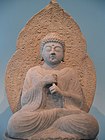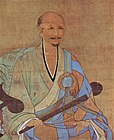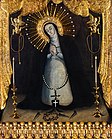History of Asian art

| History of art |
|---|
Thehistory of Asian artincludes a vast range of arts from various cultures, regions, and religions across the continent of Asia. The major regions of Asia includeCentral,East,South,Southeast,andWest Asia.
Central Asian art primarily consists of works by theTurkic peoplesof theEurasian Steppe,while East Asian art includes works from China, Japan, and Korea. South Asian art encompasses the arts of theIndian subcontinent,whileSoutheast Asian artincludes the arts of Brunei, Cambodia, East Timor, Indonesia, Laos, Malaysia, Myanmar (Burma), the Philippines, Singapore, Thailand, and Vietnam. West Asian art encompasses the arts of theNear East,including the ancient art ofMesopotamia,and more recently becoming dominated byIslamic art.
In many ways, the history of art in Asia parallels the development ofWestern art.[1][2]The art histories of Asia and Europe are greatly intertwined, with Asian art greatly influencing European art, and vice versa; the cultures mixed through methods such as theSilk Road transmission of art,the cultural exchange of theAge of Discoveryandcolonization,and through the internet and modernglobalization.[3][4][5]
Excludingprehistoric art,theart of Mesopotamiarepresents the oldest forms of art in Asia.
Upper Paleolithic Northeast Asia
[edit]
The first modern human occupation in the difficult climates of Northeast Asia is dated to circa 40,000 ago, with the earlyYana cultureof northern Siberia dated to circa 31,000 BCE. By around 21,000 BCE, two main cultures developed: theMal'ta cultureand slightly later theAfontova Gora-Oshurkovo culture.[6]
TheMal'ta cultureculture, centered around atMal'ta,at theAngara River,nearLake BaikalinIrkutsk Oblast,Southern Siberia,created some of the first works of art in theUpper Paleolithicperiod, with objects such as theVenus figurines of Mal'ta.These figures consist most often ofmammothivory. The figures are about 23,000 years old and stem from theGravettian.Most of these statuettes show stylized clothes. Quite often the face is depicted.[7]The tradition ofUpper Paleolithic portable statuettesbeing almost exclusively European, it has been suggested that Mal'ta had some kind of cultural and cultic connection with Europe during that time period, but this remains unsettled.[6][8]
Central Asian art
[edit]Art inCentral Asiais visual art created by the largelyTurkic peoplesof modern-dayKyrgyzstan,Kazakhstan,Uzbekistan,Turkmenistan,Azerbaijan,Tajikistan,Mongolia,Tibet,Afghanistan,andPakistanas well as parts of China and Russia.[9][10]In recent centuries, art in the region has been greatly influenced byIslamic art.Earlier, Central Asian art was influenced by Chinese, Greek, and Persian art, via theSilk Road transmission of art.[11]
Nomadic folk art
[edit]Nomadic Folk art serves as a vital aspect of Central Asian Art. The art reflects the core of the lifestyle of nomadic groups residing within the region. One is bound to be awestruck by the beauty of semi-precious stones, quilt, carved door, and embroidered carpets that this art reflects.[12][13]
Music and musical instrument
[edit]Central Asia is enriched with the classical music and instruments. Some of the famous classical musical instruments were originated within the Central Asian region.Rubab,Dombra,and Chang are some of the musical instruments used in the musical arts of Central Asia.[14]
The revival of Central Asian art
[edit]The lives of Central Asian people revolved around the nomadic lifestyle. Thereby most of the Central Asian arts in the modern times are also inspired by nomadic living showcasing the golden era. As a matter of fact, the touch of tradition and culture in Central Asian art acts as a major attraction factor for the international art forums. The global recognition towards the Central Asian Arts has certainly added up to its worth.[15]
East Asian art
[edit]
Chinese art
[edit]Chinese art (Chinese: Trung Quốc nghệ thuật / Trung Quốc nghệ thuật ) has varied throughout itsancient history,divided into periods by the rulingdynasties of Chinaand changing technology. Different forms of art have been influenced by great philosophers, teachers, religious figures, and even political leaders. Chinese art encompassesfine arts,folk arts,andperformance arts.Chinese art is art, whether modern or ancient, that originated from or is practiced in China or by Chinese artists or performers.
In theSong dynasty,poetry was marked by a lyric poetry known asCi( từ ) which expressed feelings of desire, often in an adopted persona. Also in the Song dynasty, paintings of more subtle expressions of landscapes appeared, with blurred outlines and mountain contours which conveyed distance through an impressionistic treatment of natural phenomena. It was during this period that in painting, emphasis was placed on spiritual rather than emotional elements, as in the previous period.Kunqu,the oldest extant form of Chinese opera developed during the Song dynasty inKunshan,near present-day Shanghai. In theYuan dynasty,painting by the Chinese painterZhao Mengfu( Triệu Mạnh phủ ) greatly influenced later Chinese landscape painting, and the Yuan dynasty opera became a variant of Chinese opera which continues today asCantonese opera.
Chinese painting and calligraphy art
[edit]Chinese painting
Gongbi and Xieyi are two painting styles in Chinese painting.
Gongbi means "meticulous", the rich colours and details in the picture are its main features, its content mainly depicts portraits or narratives. Xieyi means 'freehand', its form is often exaggerated and unreal, with an emphasis on the author's emotional expression and usually used in depicting landscapes.[16]
In addition to paper and silk, traditional paintings have also been done on the walls, such as theMogao Grottoesin Gansu Province. TheDunhuang Mogao Grottoeswere built in theNorthern Wei dynasty(386–534 AD). It consists of more than 700 caves, of which 492 caves have murals on the walls, totalling more than 45,000 square meters.[17][18]The murals are very broad in content, include Buddha statues, paradise, angels, important historical events, and even donors. The painting styles in early caves received influence from India and the West. From theTang dynasty(618–906 CE), the murals began to reflect the unique Chinese painting style.[19]
Chinese Calligraphy

Chinese calligraphy can be traced back to the Dazhuan (large seal script) that appeared in theZhou dynasty.AfterEmperor Qinunified China, Prime Minister Li Si collected and compiled Xiaozhuan (small seal) style as the new official text. The small seal script is very elegant but difficult to write quickly. In theEastern Han dynasty,a type of script called the Lishu (Official Script) began to rise. Because it reveals no circles and very few curved lines, it is very suitable for fast writing. After that, the Kaishu style (traditional regular script) has appeared, and as its structure is simpler and neater, this script is still widely used today.[20][21]
Ancient Chinese crafts
[edit]
Jade
Early jade was used as an ornament or as sacrificial utensils. The earliest Chinese carved-jade object appeared in the Hemudu culture in the earlyNeolithic period(about 3500–2000 BCE). During theShang dynasty(c. 1600–1046 BCE), Bi (circular perforated jade) and Cong (square jade tube) appeared, which were presumed to be sacrificial utensils, representing the sky and the earth. In theZhou dynasty(1046–256 BCE), due to the use of higher hardness engraving tools, jades were carved more delicately and began to be used as a pendant or ornament in clothing.[22][23]Jade was considered to be immortal and could protect the owner, so carved-jade objects were often buried with the deceased, such as a jade burial suit from the tomb of Liu Sheng, a prince of theWestern Han dynasty.[23][24]
Porcelain
Porcelain is a kind of ceramic made from kaolin at high temperature. The earliest ceramics in China appeared in theShang dynasty(c.1600–1046 BCE). And the production of ceramics laid the foundation for the invention of porcelain. The history of Chinese porcelain can be traced back to theHan dynasty(206 BC – 220 AD).[25]In theTang dynasty,porcelain was divided into celadon and white porcelain. In theSong dynasty,Jingdezhenwas selected as the royal porcelain production centre and began to produce blue and white porcelain.[26]
Modern Chinese art
[edit]After the end of thelast feudal dynasty in China,with the rise of thenew cultural movement,Chinese artists began to be influenced by Western art and began to integrate Western art into Chinese culture.[27]Influenced by American jazz, Chinese composerLi Jinhui(Known as the father of Chinese pop music) began to create and promote popular music, which made a huge sensation.[28]At the beginning of the 20th century, oil paintings were introduced to China, and more and more Chinese painters began to touch Western painting techniques and combine them with traditional Chinese painting.[29]Meanwhile, a new form of painting, comics, had also begun to rise. It was popular with many people and became the most affordable way to entertain at the time.[30]
Tibetan art
[edit]

Tibetan artrefers to the art ofTibet(Tibet Autonomous Regionin China) and other present and formerHimalayankingdoms (Bhutan,Ladakh,Nepal, andSikkim). Tibetan art is first and foremost a form ofsacred art,reflecting the overriding influence ofTibetan Buddhismon these cultures. The Sand Mandala (Tib:kilkhor) is aTibetan Buddhisttradition which symbolises the transitory nature of things. As part ofBuddhistcanon, all things material are seen as transitory. A sandmandalais an example of this, being that once it has been built and its accompanying ceremonies and viewing are finished, it is systematicallydestroyed.
AsMahayana Buddhismemerged as a separate school in the 4th century BC it emphasized the role ofbodhisattvas,compassionate beings who forgo their personal escape toNirvanain order to assist others. From an early time various bodhisattvas were also subjects of statuary art. Tibetan Buddhism, as an offspring of Mahayana Buddhism, inherited this tradition. But the additional dominating presence of theVajrayana(or Buddhist tantra) may have had an overriding importance in the artistic culture. A common bodhisattva depicted in Tibetan art is the deityChenrezig(Avalokitesvara), often portrayed as a thousand-armed saint with an eye in the middle of each hand, representing the all-seeing compassionate one who hears our requests. This deity can also be understood as aYidam,or 'meditation Buddha' for Vajrayana practice.
Tibetan Buddhism containsTantric Buddhism,also known asVajrayanaBuddhism for its common symbolism of thevajra,the diamond thunderbolt (known inTibetanas thedorje). Most of the typical Tibetan Buddhist art can be seen as part of the practice of tantra. Vajrayana techniques incorporate many visualizations/imaginations during meditation, and most of the elaborate tantric art can be seen as aids to these visualizations; from representations of meditational deities (yidams) tomandalasand all kinds of ritual implements.
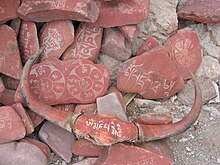
A visual aspect of Tantric Buddhism is the common representation ofwrathful deities,often depicted with angry faces, circles of flame, or with the skulls of the dead. These images represent theProtectors(Skt.dharmapala) and their fearsome bearing belies their true compassionate nature. Actually, their wrath represents their dedication to the protection of thedharmateaching as well as to the protection of the specific tantric practices to prevent corruption or disruption of the practice. They are most importantly used as wrathful psychological aspects that can be used to conquer the negative attitudes of the practitioner.
Historians note thatChinese paintinghad a profound influence on Tibetan painting in general. Starting from the 14th and 15th century, Tibetan painting had incorporated many elements from the Chinese, and during the 18th century, Chinese painting had a deep and far-reaching impact on Tibetan visual art.[31]According toGiuseppe Tucci,by the time of the Qing dynasty, "a new Tibetan art was then developed, which in a certain sense was a provincial echo of the Chinese 18th century's smooth ornate preciosity."[31]
Japanese art
[edit]
Japanese artand architecture include works of art produced in Japan from the beginnings of human habitation there, sometime in the 10th millennium BC, to the present. Japanese art covers a wide range of art styles and media, including ancient pottery, sculpture in wood and bronze, ink painting on silk and paper, and a myriad of other types of works of art; from ancient times until the contemporary 21st century.
The art form rose to great popularity in the metropolitan culture ofEdo(Tokyo) during the second half of the 17th century, originating with the single-color works ofHishikawa Moronobuin the 1670s. At first, onlyIndia inkwas used, then some prints were manually colored with a brush, but in the 18th centurySuzuki Harunobudeveloped the technique of polychrome printing to producenishiki-e.

Japanese painting(Hội họa,Kaiga)is one of the oldest and most highly refined of theJapanese arts,encompassing a wide variety of genre and styles. As with the history of Japanese arts in general, the history of Japanese painting is a long history of synthesis and competition between nativeJapanese aestheticsand adaptation of imported ideas.
The origins of painting in Japan date well back intoJapan's prehistoric period.Simple stick figures and geometric designs can be found onJōmon periodpottery andYayoi period(300 BC – 300 AD)dōtakubronze bells.Muralpaintings with both geometric and figurative designs have been found in numeroustumulusfrom theKofun period(300–700 AD).
AncientJapanese sculpturewas mostly derived from theidol worshipinBuddhismor animistic rites ofShintodeity. In particular, sculpture among all the arts came to be most firmly centered around Buddhism. Materials traditionally used were metal—especiallybronze—and, more commonly, wood, oftenlacquered,gilded,or brightly painted. By the end of theTokugawa period,such traditional sculpture – except for miniaturized works – had largely disappeared because of the loss of patronage by Buddhist temples and the nobility.
Ukiyo,meaning "floating world", refers to the impetuous young culture that bloomed in the urban centers ofEdo(modern-day Tokyo),Osaka,andKyotothat were a world unto themselves. It is an ironic allusion to thehomophoneterm "Sorrowful World" ( ưu き thế ), the earthly plane of death and rebirth from which Buddhists sought release.
Korean art
[edit]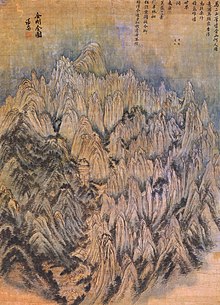
Korean artis noted for its traditions in pottery, music, calligraphy, painting, sculpture, and other genres, often marked by the use of bold color, natural forms, precise shape and scale, and surface decoration.
While there are clear and distinguishing differences between three independent cultures, there are significant and historical similarities and interactions between the arts ofKorea,China, and Japan.
The study and appreciation ofKorean artis still at a formative stage in the West. Because ofKorea's position between China and Japan, Korea was seen as a mere conduit of Chinese culture to Japan. However, recent scholars have begun to acknowledge Korea's own unique art, culture, and important role in not only transmitting Chinese culture but assimilating it and creating a unique culture of its own.An art given birth to and developed by a nation is its own art.
Generally, the history ofKorean paintingis dated to approximately 108 C.E., when it first appears as an independent form. Between that time and the paintings and frescoes that appear on theGoryeodynasty tombs, there has been little research. Suffice to say that until theJoseon dynastythe primary influence was Chinese painting though done with Korean landscapes, facial features, Buddhist topics, and an emphasis on celestial observation in keeping with the rapid development of Korean astronomy.
Throughout the history of Korean painting, there has been a constant separation of monochromatic works of black brushwork on very often mulberry paper or silk; and the colourful folk art ormin-hwa,ritual arts, tomb paintings, and festival arts which made extensive use of colour.
This distinction was often class-based: scholars, particularly inConfucian art,felt that one could see colour in monochromatic paintings within the gradations and felt that the actual use of colour coarsened the paintings, and restricted the imagination. Korean folk art, and painting of architectural frames was seen as brightening certain outside wood frames, and again within the tradition of Chinese architecture, and the early Buddhist influences of profuse rich thalo and primary colours inspired by theArt of India.
Contemporary art in Korea:The first example ofWestern-style oil paintingin Korean art was in the self-portraits of Korean artistKo Hu i-dong(1886–1965). Only three of these works still remain today. These self-portraits impart an understanding of the medium that extends well beyond the affirmation of stylistic and cultural difference. By the early twentieth century, the decision to paint using oil and canvas in Korea had two different interpretations. One being a sense of enlightenment due to western ideas and art styles. This enlightenment derived from an intellectual movement of the seventeenth and eighteenth centuries. Ko had been painting with this method during a period of Japan's annexation of Korea. During this time many claimed his art could have been political, however, he himself stated he was an artist and not a politician. Ko stated, "While I was in Tokyo, a very curious thing happened. At that time there were fewer than one hundred Korean students in Tokyo. All of us were drinking the new air and embarking on new studies, but there were some who mocked my choice to study art. A close friend said that it was not right for me to study painting in such a time as this."[33]
Korean potterywas recognized as early as 6000 BCE. This pottery was also referred to as comb-patterned pottery due to the decorative lines carved onto the outside. Early Korean societies were mainly dependent on fishing. So, they used pottery to store fish and other things collected from the ocean such as shellfish. Pottery had two main regional distinctions. Those from the East coast tend to have a flat base, whereas pottery on the South coast had a round base.[34]
South Asian art
[edit]Pakistani art
[edit]Pakistani arthas a long tradition and history. It consists of a variety of art forms, includingpainting,sculpture,calligraphy,pottery,andtextile artssuch as woven silk. Geographically, it is a part of theIndian subcontinent art,including what is nowPakistan.[35]
Buddhist art
[edit]
Buddhist artoriginated in theIndian subcontinentin the centuries following the life of the historicalGautama Buddhain the 6th to 5th century BCE, before evolving through its contact with other cultures and its diffusion through the rest of Asia and the world. Buddhist art traveled with believers as the dharma spread, adapted, and evolved in each new host country. It developed to the north through Central Asia and into East Asia to form the Northern branch of Buddhist art, and to the east as far as Southeast Asia to form the Southern branch of Buddhist art. In India, Buddhist art flourished and even influenced the development ofHinduart, until Buddhism nearly disappeared in India around the 10th century CE due in part to the vigorous expansion of Islam alongsideHinduism.
A common visual device in Buddhist art is themandala.From a viewer's perspective, it represents schematically the ideal universe.[36][37]In various spiritual traditions, mandalas may be employed for focusing the attention of aspirants and adepts, a spiritual teaching tool, for establishing asacred space,and as an aid tomeditationandtranceinduction. Its symbolic nature can help one "to access progressively deeper levels of the unconscious, ultimately assisting the meditator to experience a mystical sense of oneness with the ultimate unity from which the cosmos in all its manifold forms arises."[38]ThepsychoanalystCarl Jungsaw the mandala as "a representation of the centre of the unconscious self,"[39]and believed his paintings of mandalas enabled him to identify emotional disorders and work towards wholeness in personality.[40]
Bhutanese art
[edit]
Bhutanese artis similar to theart of Tibet.Both are based uponVajrayana Buddhism,with its pantheon of divine beings.
The major orders of Buddhism in Bhutan areDrukpa KagyuandNyingma.The former is a branch of theKagyu Schooland is known for paintings documenting the lineage of Buddhist masters and the 70Je Khenpo(leaders of the Bhutanese monastic establishment). The Nyingma order is known for images ofPadmasambhava,who is credited with introducing Buddhism into Bhutan in the 7th century. According to legend, Padmasambhava hid sacred treasures for future Buddhist masters, especiallyPema Lingpa,to find. Thetreasure finders(tertön) are also frequent subjects of Nyingma art.
Each divine being is assigned special shapes, colors, and/or identifying objects, such as lotus, conch-shell, thunderbolt, and begging bowl. All sacred images are made to exact specifications that have remained remarkably unchanged for centuries.

Bhutanese art is particularly rich in bronzes of different kinds that are collectively known by the nameKham-so(made inKham) even though they are made in Bhutan, because the technique of making them was originally imported from the eastern province ofTibetcalled Kham. Wall paintings and sculptures, in these regions, are formulated on the principal ageless ideals of Buddhist art forms. Even though their emphasis on detail is derived from Tibetan models, their origins can be discerned easily, despite the profusely embroidered garments and glittering ornaments with which these figures are lavishly covered. In the grotesque world of demons, the artists apparently had greater freedom of action than when modeling images of divine beings.
The arts and crafts ofBhutanthat represent the exclusive “spirit and identity of the Himalayan kingdom" are defined as the art ofZorig Chosum,which means the “thirteen arts and crafts of Bhutan”; the thirteen crafts are carpentry, painting, paper making, blacksmithing, weaving, sculpting, and many other crafts. The Institute of Zorig Chosum inThimphuis the premier institution of traditional arts and crafts set up by the Government of Bhutan with the sole objective of preserving the rich culture and tradition of Bhutan and training students in all traditional art forms; there is another similar institution in eastern Bhutan known as Trashi Yangtse. Bhutanese rural life is also displayed in the ‘Folk Heritage Museum’ in Thimphu. There is also a ‘Voluntary Artists Studio’ in Thimphu to encourage and promote the art forms among the youth of Thimphu.[41][42]
Indian art
[edit]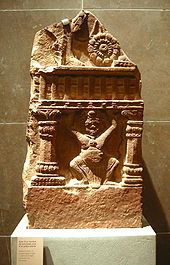

Indian artcan be classified into specific periods, each reflecting certain religious, political, and cultural developments. The earliest examples are thepetroglyphssuch as those found inBhimbetka,some of them dating to before 5500 BC. The production of such works continued for several millennia.
The art of theIndus Valley Civilizationfollowed. Later examples include the carvedpillarsofEllora,Maharashtrastate.Other examples are thefrescoesofAjantaandEllora Caves.
The contributions of theMughal Empireto Indian art includeMughal painting,a style of miniature painting heavily influenced byPersian miniatures,andMughal architecture.
During theBritish Raj,modern Indian paintingevolved as a result of combining traditional Indian and European styles.Raja Ravi Varmawas a pioneer of this period. TheBengal school of Artdeveloped during this period, led byAbanidranath Tagore,Gaganendranath Tagore,Jamini Roy,Mukul Dey,andNandalal Bose.
One of the most popular art forms inIndiais calledRangoli.It is a form ofsandpaintingdecoration that uses finely ground white powder and colours, and is used commonly outside homes in India.
The visual arts (sculpture, painting, and architecture) are tightly interrelated with the non-visual arts. According toKapila Vatsyayan,"Classical Indian architecture, sculpture, painting, literature (kaavya), music, and dancing evolved their own rules conditioned by their respective media, but they shared with one another not only the underlying spiritual beliefs of the Indian religio-philosophic mind, but also the procedures by which the relationships of the symbol and the spiritual states were worked out in detail."
Insight into the unique qualities of Indian art is best achieved through an understanding of the philosophical thought, the broad cultural history, social, religious, and political background of the artworks.
Specific periods:
- Hinduism,JainismandBuddhismof the ancient period (3500BCE– present)
- Islamic ascendancy (712–1757CE)
- The colonial period (1757–1947)
- Modern and Postmodern art in India
- Independence and thepostcolonialperiod (Post-1947)
Nepalese art
[edit]The ancient and refined traditionalculture ofKathmandu,for that matter in the whole ofNepal,is an uninterrupted and exceptional meeting of theHinduandBuddhistethos practiced by its highly religious people. It has also embraced in its fold the cultural diversity provided by the other religions such asJainism,Islam,andChristianity.
Southeast Asian art
[edit]Bruneian art
[edit]Silver is a popular element inBruneian art.Silversmithsmake ornaments, flower vases andgongs(metal disk with a turned rim giving a resonant note when stuck). Another popular utensil ispasigupan,a type of mini pot that has amandalaprint and holds tobacco.
Weaving skills have been passed across generations. Brunei produces fabric for making gowns andsarongs."The weaving and decoration of cloth as well as wearing, display, and exchange of it, has been an important part of Bruneian culture for years (Orr 96)." Weaving became significant in the 15th century.Antonio Pigafettavisited Brunei during his travels and observed how the clothes were made. One example was a Jongsarat, a handmade garment used for weddings and special occasions. It typically includes a hint of silver and gold. It can be used for wall coverings.
The two types of clothing in Brunei are calledBatikandIkat.Batik is dyed cotton cloth decorated through a technique known aswax-resist dyeing.[43]Ikat is made through a similar process as Batik, Instead of dyeing the pattern onto finished cloth, it is created during weaving.
Cambodian art
[edit]
Cambodian artand the culture ofCambodiahas had a rich and varied history dating back many centuries and has been heavily influenced byIndia.In turn, Cambodia greatly influencedThailand,Laos, and vice versa. Throughout Cambodia's long history, a major source of inspiration was from religion. Throughout nearly two millennia, Cambodians developed a uniqueKhmerbelief from the syncreticism of indigenousanimisticbeliefs and the Indian religions ofBuddhismandHinduism.Indian culture and civilization, including its language and arts, reached mainland Southeast Asia around the 1st century CE.[44]It is generally believed that seafaring merchants brought Indian customs and culture to ports along the gulf of Thailand and the Pacific while trading with China. The first state to benefit from this wasFunan.At various times, Cambodian culture also absorbed elements fromJavanese,Chinese,Lao,andThaicultures.[45]
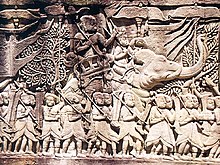
The history of thevisual arts of Cambodiastretches back centuries to ancient crafts; Khmer art reached its peak during theAngkorperiod. Traditional Cambodian arts and crafts include textiles, non-textileweaving,silversmithing,stone carving,lacquerware,ceramics,watmurals,andkite-making.[46]Beginning in the mid-20th century, a tradition of modern art began in Cambodia, though in the later 20th century both traditional and modern arts declined for several reasons, including the killing of artists by theKhmer Rouge.The country has experienced a recent artistic revival due to increased support from governments, NGOs, and foreign tourists.[47]
Khmer sculpture
[edit]Khmer sculpturerefers to the stone sculpture of theKhmer Empire,which ruled a territory based on modern Cambodia, but rather larger, from the 9th to the 13th century. The most celebrated examples are found inAngkor,which served as the seat of the empire.
By the 7th century, Khmer sculpture begins to drift away from its Hindu influences – pre-Gupta for the Buddhist figures, Pallava for the Hindu figures – and through constant stylistic evolution, it comes to develop its own originality, which by the 10th century can be considered complete and absolute. Khmer sculpture soon goes beyond religious representation, which becomes almost a pretext in order to portray court figures in the guise of gods and goddesses.[48]But furthermore, it also comes to constitute a means and end in itself for the execution of stylistic refinement, like a kind of testing ground. We have already seen how the social context of the Khmer kingdom provides a second key to understanding this art. But we can also imagine that on a more exclusive level, small groups of intellectuals and artists were at work, competing among themselves in mastery and refinement as they pursued a hypothetical perfection of style.[49]
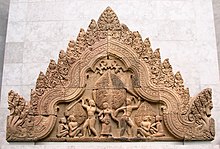
The gods we find in Khmer sculpture are those of the two great religions of India,BuddhismandHinduism.And they are always represented with great iconographic precision, clearly indicating that learned priests supervised the execution of the works.[45]Nonetheless, unlike those Hindu images which repeat an idealized stereotype, these images are treated with great realism and originality because they depict living models: the king and his court. The true social function of Khmer art was, in fact, the glorification of thearistocracythrough these images of the gods embodied in the princes. In fact, the cult of the “deva-raja” required the development of an eminently aristocratic art in which the people were supposed to see the tangible proof of the sovereign's divinity, while the aristocracy took pleasure in seeing itself – if, it's true, in idealized form – immortalized in the splendour of intricate adornments, elegant dresses, and extravagant jewelry.[50]
The sculptures are admirable images of gods, royal and imposing presences, though not without feminine sensuality, making us think of important persons at the courts and persons of considerable power. The artists who sculpted the stones doubtless satisfied the primary objectives and requisites demanded by the persons who commissioned them. The sculptures represent the chosen divinity in the orthodox manner and succeed in portraying, with great skill and expertise, high figures of the courts in all of their splendour, in the attire, adornments, and jewelry of a sophisticated beauty.[51]
Filipino art
[edit]


The earliest knownFilipino artsare the rock arts, where the oldest is theAngono Petroglyphs,made during the Neolithic age, dated between 6000 and 2000 BC. The carvings were possibly used as part of an ancient healing practice for sick children. This was followed by theAlab Petroglyphs,dated not later than 1500 BC, which exhibited symbols of fertility such as a pudenda. The rock arts are petrographs, including the charcoal rock art fromPeñablanca,charcoal rock art fromSingnapan,red hematite art atAnda,[52]and the recently discovered rock art fromMonreal (Ticao),depicting monkeys, human faces, worms or snakes, plants, dragonflies, and birds.[53]Between 890 and 710 BC, theManunggul Jarwas made in southernPalawan.It served as a secondary burial jar, where the top cover depicts the journey of the soul into the afterlife through a boat with apsychopomp.[54]In 100 BC, theKabayan Mummy Burial Caveswere carved from a mountain. Between 5 BC-225 AD, theMaitum anthropomorphic potterywere created in Cotabato. The crafts were secondary burial jars, with many depicting human heads, hands, feet, and breast.[55]
By the 4th century AD, and most likely before that, ancient people from the Philippines have been making giant warships, where the earliest known archaeological evidences have been excavated fromButuan,where the ship was identified as abalangayand dated at 320 AD.[56]The oldest, currently found, artifact with a written script on it is theLaguna Copperplate Inscription,dated 900 AD. The plate discusses the payment of a debt.[57]TheButuan Ivory Sealis the earliest known ivory art in the country, dated between the 9th to 12th century AD. The seal contains carvings of an ancient script.[58]During this period, various artifacts were made, such as theAgusan image,a gold statue of a deity, possibly influenced by Hinduism and Buddhism.[59]From the 12th to 15th century, theButuan Silver Paleographwas made. The script on the silver has yet to be deciphered.[60]Between the 13th–14th century, the natives of Banton, Romblon, crafted theBanton cloth,the oldest survivingikattextile in Southeast Asia. The cloth was used as a death blanket.[61]By the 16th century, up to the late 19th century, Spanish colonization influenced various forms of art in the country.[62]
From 1565 to 1815, Filipino craftsfolk were making theManila galleonsused for the trading from Asia to the Americas, where many of the goods went to Europe.[63]In 1565, the ancient tradition of tattooing in the Philippines was first recorded through thePintados.[64]In 1584,Fort San Antonio Abadwas completed, while in 1591,Fort Santiagowas built. By 1600, theRice Terraces of the Philippine Cordilleraswere made. Five rice terrace clusters have been designated asWorld Heritage Sites.[65]In 1607, theSan Agustin Church (Manila)was built. The building has been declared as aWorld Heritage Site.The site is famous for its painted interior.[66]In 1613, the oldest survivingsuyatwriting on paper was written through theUniversity of Santo Tomas Baybayin Documents.[67]Following 1621, theMonreal Stoneswere created in Ticao, Masbate.[68]In 1680, theArch of the Centurieswas made. In 1692, the image ofNuestra Senora de la Soledad de Porta Vagawas painted.[69]
Manaoag Churchwas established in 1701. In 1710, theWorld Heritage SiteofPaoay Churchwas built. The church is known for its giant buttresses, part of the earthquake Baroque architecture.[66]In 1720, the religious paintings at Camarin de la Virgen in Santa Ana were made.[70]In 1725, the historicalSanta Ana Churchwas built. In 1765, the World Heritage Site ofSanta Maria Churchwas built. The site is notable for its highland structure.[66]Bacarra Churchwas built in 1782. In 1783, theidjangs,castle-fortresses, of Batanes were first recorded. The exact age of the structures are still unknown.[71]In 1797, theWorld Heritage SiteofMiagao Churchwas built. The church is famous for its facade carvings.[66]Tayum Churchwas built in 1803. In 1807, the Basi Revolt paintings were made, depicting the Ilocano revolution against Spanish interference on basi production and consumption. In 1822, the historicalPaco Parkwas established. In 1824, theLas Piñas Bamboo Organwas created, becoming the first and only organ made of bamboo. By 1852, theSacred Art paintings of the Parish Church of Santiago Apostolwere finished. In 1884, both theAssassination of Governor Bustamante and His SonandSpoliariumwon prizes during an art competition in Spain. In 1890, the painting,Feeding the Chicken,was made.The Parisian Lifewas painted in 1892, whileLa Bulaqueñawas painted in 1895. The clay art,The Triumph of Science over Death,was crafted in 1890.[72]In 1891, the first and only all-steel church in Asia,San Sebastian Church (Manila),was built. In 1894, the clay artMother's Revengewas made.[73]
In the 20th century, or possibly earlier, the Koran of Bayang was written. During the same time, the Stone Agricultural Calendar of Guiday, Besao, was discovered by outsiders. In 1913, theRizal Monumentwas completed. In 1927, theUniversity of Santo Tomas Main Buildingwas rebuilt, while its Central Seminary Building was built in 1933. In 1931, the royal palaceDarul Jambanganof Sulu was destroyed.[74]On the same year, theManila Metropolitan Theaterwas built.The Progress of Medicine in the Philippinespaintings were finished in 1953.Santo Domingo Churchwas built in 1954. In 1962, theInternational Rice Research Institutepainting was completed, while theManila Muralwas made in 1968. In 1993, theBonifacio Monumentwas created.[70][60]
Indonesian art
[edit]
Indonesian artand culture has been shaped by longinteractionbetween original indigenous customs and multiple foreign influences.Indonesiais central along ancienttrading routesbetween the Far East and the Middle East, resulting in many cultural practices being strongly influenced by a multitude ofreligions,includingHinduism,Buddhism,Confucianism,and Islam, all strong in the major trading cities. The result is a complex cultural mixture very different from the original indigenous cultures. Indonesia is not generally known for paintings, aside from the intricate and expressiveBalinesepaintings, which often express natural scenes and themes from the traditional dances.

Other exceptions include indigenousKenyahpaint designs based on, as commonly found amongAustronesiancultures, endemic natural motifs such as ferns, trees, dogs, hornbills, and human figures. These are still to be found decorating the walls of Kenyah DayaklonghousesinEast Kalimantan's Apo Kayan region.
Indonesia has a long-heBronzeandIron Ages,but the art-form particularly flourished from the 8th century to the 10th century, both as standalone works of art, and also incorporated into temples.
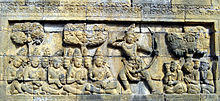
Most notable are the hundreds of meters of relief sculptures at the temple ofBorobudurin centralJava.Approximately two miles of exquisite relief sculptures tell the story of the life ofBuddhaand illustrate his teachings. The temple was originally home to 504 statues of the seated Buddha. This site, as with others in central Java, show a clear Indian influence.
Calligraphy, mostly based on theQur'an,is often used as decoration as Islam forbids naturalistic depictions. Some foreign painters have also settled inIndonesia.Modern Indonesian painters use a wide variety of styles and themes.
Balinese art
[edit]
Balinese artis art ofHindu-Javaneseorigin that grew from the work of artisans of theMajapahit Kingdom,with their expansion toBaliin the late 13th century. From the 16th until the 20th centuries, the village of Kamasan, Klungkung (East Bali), was the centre of classical Balinese art. During the first part of the 20th century, new varieties of Balinese art developed. Since the late twentieth century,Ubudand its neighboring villages established a reputation as the center of Balinese art. Ubud andBatuanare known for their paintings,Masfor their woodcarvings, Celuk for gold and silversmiths, and Batubulan for their stone carvings. Covarrubias[75]describes Balinese art as, "... a highly developed, although informal Baroque folk art that combines the peasant liveliness with the refinement of classicism of Hinduistic Java, but free of the conservative prejudice and with a new vitality fired by the exuberance of the demonic spirit of the tropical primitive". Eiseman pointed out that Balinese art is actually carved, painted, woven, and prepared into objects intended for everyday use rather than asobject d 'art.[76]
In the 1920s, with the arrival of many western artists, Bali became an artist enclave (asTahitiwas forPaul Gauguin) for avant-garde artists such asWalter Spies(German),Rudolf Bonnet(Dutch),Adrien-Jean Le Mayeur(Belgian),Arie Smit(Dutch), andDonald Friend(Australian) in more recent years. Most of these western artists had very little influence on the Balinese until the post-World War Two period, although some accounts over-emphasise the western presence at the expense of recognising Balinese creativity.
This groundbreaking period of creativity reached a peak in the late 1930s. A stream of famous visitors, includingCharlie Chaplinand theanthropologistsGregory BatesonandMargaret Mead,encouraged the talented locals to create highly original works. During their stay in Bali in the mid-1930s, Bateson and Mead collected over 2000 paintings, predominantly from the village of Batuan, but also from the coastal village of Sanur.[77] Among western artists, Spies and Bonnet are often credited for the modernization of traditional Balinese paintings. From the 1950s onwards, Baliese artists incorporated aspects of perspective and anatomy from these artists.[78] More importantly, they acted as agents of change by encouraging experimentation, and promoted departures from tradition. The result was an explosion of individual expression that increased the rate of change in Balinese art.
Lao art
[edit]
Laotian artincludesceramics,Lao Buddhist sculpture,andLao music.
Lao Buddhist sculptures were created in a large variety of material including gold, silver, and, most often,bronze.Brick-and-mortar was also a medium used for colossal images, most famous of these is the image ofPhya Vat(16th century) inVientiane,although a renovation completely altered the appearance of the sculpture, and it no longer resembles a Lao Buddha. Wood is popular for small, votive Buddhist images that are often left in caves. Wood is also very common for large, life-size standing images of the Buddha. The most famous two sculptures carved in semi-precious stone are the Phra Keo (TheEmerald Buddha) and the Phra Phuttha Butsavarat. The Phra Keo, which is probably of Xieng Sen (Chiang Saen) origin, is carved from a solid block of jade. It rested in Vientiane for two hundred years before the Siamese carried it away as booty in the late 18th century. Today it serves as thepalladiumof the Kingdom of Thailand, and resides at theGrand Palacein Bangkok. The Phra Phuttha Butsavarat, like the Phra Keo, is also enshrined in its own chapel at the Grand Palace in Bangkok. Before the Siamese seized it in the early 19th century, this crystal image was the palladium of the Lao kingdom ofChampassack.
Many beautiful Lao Buddhist sculptures are carved right into thePak Ou caves.NearPak Ou(mouth of the Ou river) theTham Ting(lower cave) and theTham Theung(upper cave) are nearLuang Prabang,Laos. They are a magnificent group of caves that are only accessible by boat, about two hours upstream from the center ofLuang Prabang,and have recently become more well-known and frequented by tourists. The caves are noted for their impressiveBuddhistandLaostyle sculptures carved into the cave walls, and hundreds of discardedBuddhistfigures laid out over the floors and wall shelves. They were put there as their owners did not wish to destroy them, so a difficult journey is made to the caves to place their unwanted statues there.
Malaysian art
[edit]Malaysian artis primarily composed ofMalay artandBornean art,holding similarities with the other styles from Southeast Asia, such that ofBrunei,Indonesia,andSingapore.The history of art in Malaysia dates back to the Malay sultanates, with influences fromChinese,IndianandIslamicarts.
TraditionalMalaysianart is mainly centred on the crafts of carving, weaving, and silversmithing.[79]Traditional art ranges from handwoven baskets from rural areas to the silverwork of the Malay courts. Common artworks included ornamentalkrisandbeetle nutsets. Luxurious textiles known asSongketare made, as well as traditional patternedbatikfabrics. Indigenous East Malaysians are known for their wooden masks. Malaysian art has expanded only recently, as before the 1950s Islamic taboos about drawing people and animals were strong.[80]Textiles such as thebatik,songket,Pua Kumbu,andtekatare used for decorations, often embroidered with a painting or pattern. Traditional jewelry was made from gold and silver adorned with gems, and, in East Malaysia, leather and beads were used to the same effect.[81]
Myanmar art
[edit]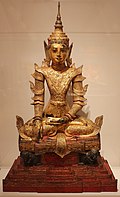
Art of Myanmarrefers to visual art created inMyanmar(Burma). Ancient Burmese art was influenced by India and was often religious in nature, ranging fromHindusculptures in theThaton KingdomtoTheravada Buddhistimages in theSri Ksetra Kingdom.[82]
The Bagan period saw significant developments in many art forms from wall paintings and sculptures tostuccoand wood carving.[82]After a dearth of surviving art between the 14th and 16th century,[83]artists created paintings and sculptures that reflect the Burmese culture.[84]Burmese artists have been subjected to government interference and censorship, hindering the development of art in Myanmar.[85]Burmese art reflects the central Buddhist elements including themudra,Jataka tales,thepagoda,andBodhisattva.[86]
Singaporean art
[edit]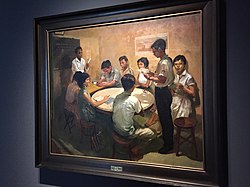
The history ofSingaporean artincludes the indigenous artistic traditions of theMalay Archipelagoand the diverse visual practices of itinerant artists and migrants fromChina,theIndian subcontinent,andEurope.[87]
Singaporean art includes the sculptural,textile,anddecorative arttraditions of theMalay world;portraiture,landscapes,sculpture,printmaking,andnatural historydrawings from the country's British colonial period; along with Chinese-influencedNanyang stylepaintings,social realist art,abstract art,andphotographypractices emerging in the post-war period.[87]Today, it includes thecontemporary artpractices of post-independence Singapore, such asperformance art,conceptual art,installation art,video art,sound art,andnew media art.[88]The emergence ofmodernSingaporean art, or more specifically, "the emergence of self-aware artistic expression"[87]is often tied to the rise of art associations, art schools, and exhibitions in the 20th century, though this has since been expanded to include earlier forms of visual representation, such as from Singapore's historical periods.[89][90]
Presently, thecontemporary artof Singapore also circulates internationally through artbiennalesand other major international exhibitions. Contemporary art in Singapore tends to examine themes of "hyper-modernity and the built environment; alienation and changing social mores;post-colonialidentities andmulticulturalism."[91]Across these tendencies, "the exploration ofperformanceand the performative body "is a common running thread.[91]Singapore carries a notable history ofperformance art,with the government historically having enacted a no-funding rule for that specific art form from 1994 to 2003, following a controversial performance artwork at the5th Passageart space.[92][93]
Thai art
[edit]
Thai artandvisual artwas traditionally and primarilyBuddhistand Royal Art. Sculpture was almost exclusively ofBuddha images,while painting was confined to theillustrationof books and decoration of buildings, primarilypalacesand temples. ThaiBuddha imagesfrom different periods have a number of distinctive styles. Contemporary Thai art often combines traditional Thai elements withmoderntechniques.
Traditional Thai paintings showed subjects in twodimensionswithoutperspective.The size of each element in the picture reflected its degree of importance. The primary technique ofcompositionis that of apportioning areas: the main elements are isolated from each other by space transformers. This eliminated the intermediate ground, which would otherwise imply perspective. Perspective was introduced only as a result of Western influence in the mid-19th century.
The most frequent narrative subjects for paintings were or are: theJatakastories, episodes from the life of theBuddha,the Buddhistheavensandhells,and scenes of daily life.
The Sukhothai period began in the 14th century in theSukhothai kingdom.Buddha images of the Sukhothai period are elegant, with sinuous bodies and slender, oval faces. This style emphasized the spiritual aspect of the Buddha, by omitting many smallanatomicaldetails. The effect was enhanced by the common practice ofcastingimages in metal rather thancarvingthem. This period saw the introduction of the "walking Buddha" pose.
Sukhothai artists tried to follow the canonical defining marks of a Buddha, as they are set out in ancientPalitexts:
- Skinso smooth that dust cannot stick to it;
- Legslike a deer;
- Thighslike abanyan tree;
- Shouldersas massive as an elephant's head;
- Arms round like an elephant's trunk, and long enough to touch the knees;
- Hands like lotuses about to bloom;
- Fingertipsturned back like petals;
- Headlike an egg;
- Hair like a scorpion's stingers;
- Chinlike a mango stone;
- Noselike a parrot's beak;
- Earlobeslengthened by the earrings of royalty;
- Eyelasheslike a cow's;
- Eyebrowslike drawn bows.
Sukhothai also produced a large quantity ofglazedceramicsin theSawankhalokstyle, which were traded throughout Southeast Asia.
Timor art
[edit]Art inEast Timorbegan to popularize since the violence during the2006 East Timorese crisis.Children living in the country begangraffitingwalls into peacemurals.[94][95]
TheEast Timor Arts Societypromotes the art in the area, and house many different artworks produced in the country.[96]
Vietnamese art
[edit]

Vietnamese artis from one of the oldest of such cultures in the Southeast Asian region. A rich artistic heritage that dates to prehistoric times and includes: silk painting, sculpture, pottery, ceramics, woodblock prints, architecture, music, dance, and theatre.

Traditional Vietnamese artis art practiced in Vietnam or by Vietnamese artists, from ancient times (including the elaborateĐông Sơn drums) to post-Chinese dominationart which was strongly influenced byChinese Buddhist art,among other philosophies such asTaoismandConfucianism.The art ofChampaandFrench artalso played a smaller role later on.
The Chinese influence on Vietnamese art extends intoVietnamese pottery and ceramics,calligraphy, and traditional architecture. Currently, Vietnamese lacquer paintings have proven to be quite popular.
TheNguyễn dynasty,the last ruling dynasty of Vietnam (c. 1802–1945), saw a renewed interest in ceramics and porcelain art. Imperial courts across Asia imported Vietnamese ceramics.
Despite how highly developed the performing arts (such as imperial court music and dance) became during the Nguyễn dynasty, some view other fields of art as beginning to decline during the latter part of the Nguyễn dynasty.
Beginning in the 19th century,modern artand French artistic influences spread into Vietnam. In the early 20th century, the École Supérieure des Beaux Arts de l’Indochine (Indochina College of Arts) was founded to teach European methods and exercised influence mostly in the larger cities, such asHanoiandHo Chi Minh City.[97]
Travel restrictions imposed on the Vietnamese during France's 80-year rule of Vietnam and the long period of war for national independence meant that very few Vietnamese artists were able to train or work outside of Vietnam.[98]A small number of artists from well-to-do backgrounds had the opportunity to go to France and make their careers there for the most part.[98]Examples include Le Thi Luu, Le Pho, Mai Trung Thu, Le Van De, Le Ba Dang, and Pham Tang.[98]
Modern Vietnamese artists began to utilize French techniques with many traditional mediums such as silk, lacquer, etc., thus creating a unique blend of eastern and western elements.
Vietnamese calligraphy
[edit]Calligraphy has had a long history in Vietnam, previously usingChữ Hánalong withChữ Nôm.However, most modern Vietnamese calligraphy instead uses the Roman-character basedChữ Quốc Ngữ,which has proven to be very popular.
In the past, with literacy in the old character-based writing systems of Vietnam being restricted to scholars and elites, calligraphy nevertheless still played an important part in Vietnamese life. On special occasions such as theTết Nguyên Đán,people would go to the village teacher or scholar to make them a calligraphy hanging (often poetry, folk sayings, or even single words). People who could not read or write also often commissioned scholars to write prayers which they would burn at temple shrines.
West Asian/Near Eastern art
[edit]Art of Mesopotamia
[edit]Art of Israel and the Jewish diaspora
[edit]Islamic art
[edit]Iranian art
[edit]Arab art
[edit]Gallery of art in Asia
[edit]-
Shang dynasty(Yin) bronze ritual wine vessel, dating to the 13th century BC, Chinese
-
TheTerracotta Armysculpture, 3rd century BC, Chinese
-
Seated Buddha,Gandhara,2nd century CE
-
The Buddha statue of Avukana, 5th century,Sri Lanka
-
Boddhisattva ofPlaosan,9th centuryShailendra art,Central Java, Indonesia.
-
Agusan imagegold statue (9th-10th century),Philippines
-
Song dynastyporcelain bottle with iron pigment over transparent colorless glaze, 11th century, Chinese
-
ApsarasofAngkor Wat,12th century Cambodia
-
Majapahit Terracottapiggybank,14th century East Java, Indonesia
-
Budha performingbhūmisparsa mudrāposition. Ho Phra Kaeo temple,Vientiane,Laos
-
Chrysanthemumstyled porcelain vase,Ming dynasty,1368–1644 AD, Chinese
-
A White-Robed Kannon,Bodhisattvaof Compassion,Kanō Motonobu(1476–1559), Japanese
-
A screen painting depicting people playingGo,Kanō Eitoku(1543–1590), Japanese
-
Right panel of thePine Trees screen(Shōrin-zu byōbu,Rừng thông đồ bình phong)byHasegawa Tōhaku(1539–1610), Japanese
-
Genji Monogatari,Tosa Mitsuoki,(1617–1691), Japanese
-
An underworld messenger,Joseon dynasty,Korean
-
Ivory carving of Christ Child with gold paint (c. 1580–1640),Philippines
-
After Rain at Mt. Inwang,Cheong Seon (1676–1759),Korean
-
Hell scene onKertha Gosa Pavilion,Balinese art,circa 18th century, Indonesia
-
Virgin Mary ivory head with inlaid glass eyes (18-19th century),Philippines
See also
[edit]Specific topics in Asian art
[edit]- Category:Arts in Asia by country
- Night in paintings (Eastern art)
- Scythian art
- History of Chinese art
- Culture of the Song dynasty
- Ming dynasty painting
- Tang dynasty art
- Lacquerware
- Mandala
- Emerald Buddha
- Urushi-e
- Gautama Buddha
- Buddhism and Hinduism
- List of National Treasures of Japan (paintings)
- List of National Treasures of Japan (sculptures)
General art topics
[edit]Oceania
[edit]Australia
[edit]New Zealand
[edit]References
[edit]- ^Sullivan, Michael(1997).The Meeting of Eastern and Western Art(Paperback) (Revised and expanded ed.). Berkeley:University of California Press.ISBN0-520-21236-3.
- ^Wichmann, Siegfried (1999).Japonisme: The Japanese Influence on Western Art Since 1858(Paperback). New York, NY: Thames & Hudson.ISBN0-500-28163-7.
- ^Sullivan, Michael(1989).The Meeting of Eastern and Western Art(Hardcover) (Revised and expanded ed.). Berkeley: University of California Press.ISBN0-520-05902-6.
- ^Cotter, Holland (July 10, 1994)."Art View; Eastern Art Through Western Eyes".The New York Times.RetrievedOctober 27,2007.
- ^"Ancient Near Eastern Art".Metropolitan Museum of Art.
- ^abTedesco, Laura Anne."Mal'ta (ca. 20,000 B.C.)".The Met's Heilbrunn Timeline of Art History.Metropolitan Museum of Art.
- ^Cohen, Claudine (2003).La femme des origines: images de la femme dans la préhistoire occidentale.Belin-Herscher. p. 113.ISBN978-2733503362.
- ^Karen Diane Jennett (May 2008)."Female Figurines of the Upper Paleolithic"(PDF).Texas State University.pp. 32–34.RetrievedMay 26,2016.
- ^"Central Asia".Art Gallery NSW.Archived fromthe originalon October 3, 2019.RetrievedOctober 3,2019.
- ^Hakimov, A. A.; Novgorodova, E.; Dani, A. H. (1996)."Arts and Crafts"(PDF).History of Civilizations of Central Asia.Vol. 4: The Age of Achievement, A.D. 750 to the End of the Fifteenth Century, Pt. I: The Historical, Social and Economic Setting. UNESCO Publishing. pp. 424–471.ISBN978-92-3-103654-5.Archived fromthe original(PDF)on August 13, 2016.
- ^Encyclopædia Britannica (2012)."Central Asian Arts".Encyclopædia Britannica.RetrievedMay 17,2012.
- ^"Contemporary Art in Central Asia as an Alternative Forum for Discussions".Voices on Central Asia.June 25, 2018.RetrievedOctober 3,2019.
- ^Carr, Karen (May 31, 2017)."Central Asian Art".Quatr.us Study Guides.RetrievedOctober 3,2019.
- ^Hays, Jeffrey."Culture, Art, Crafts and Music From in Central Asia".factsanddetails.RetrievedOctober 3,2019.
- ^Berczi, Szaniszlo (2009)."Ancient Art of Central-Asia".Journal of Eurasian Studies.1(3): 21–27 – via ResearchGate.
- ^Jiang, Shu-Qiang; Du, Jun; Huang, Qing-Ming; Huang, Tie-Jun; Gao, Wen (2005). "Visual Ontology Construction for Digitized Art Image Retrieval".Journal of Computer Science and Technology.20(6): 855–860.doi:10.1007/s11390-005-0855-x.S2CID12251260.
- ^Ma, Yantian; Zhang, He; Du, Ye; Tian, Tian; Xiang, Ting; Liu, Xiande; Wu, Fasi; An, Lizhe; Wang, Wanfu; Gu, Ji-Dong; Feng, Huyuan (2015)."The community distribution of bacteria and fungi on ancient wall paintings of the Mogao Grottoes".Scientific Reports.5:7752.Bibcode:2015NatSR...5E7752M.doi:10.1038/srep07752.PMC4291566.PMID25583346.S2CID11977268.
- ^Kenderdine, Sarah (2013). ""Pure Land": Inhabiting the Mogao Caves at Dunhuang ".Curator: The Museum Journal.56(2): 199–218.doi:10.1111/cura.12020.
- ^McIntire, Jennifer N. (n.d.)."Mogao Caves at Dunhuang".Khan Academy.RetrievedMay 31,2019.
- ^Yee, C. (2019). Chinese calligraphy | Description, History, & Facts. Retrieved fromhttps:// britannica /art/Chinese-calligraphy
- ^Chiang, Y. (1973).Chinese calligraphy(Vol. 60). Harvard University Press.
- ^Cartwright, M. (2019). Jade in Ancient China. Retrieved from [https:// worldhistory.org/article/1088/jade-in-ancient-china/ worldhistory.org]
- ^abSullivan, M., & Silbergeld, J. (2019). Chinese jade. Retrieved fromhttps:// britannica /art/Chinese-jade
- ^Shan, Jun (December 6, 2018)."Importance of Jade in Chinese Culture".ThoughtCo.RetrievedJune 1,2019.
- ^Valenstein, Suzanne G. (1988).A Handbook of Chinese Ceramics.New York: Metropolitan Museum of Art.
- ^"Chinese Porcelain".Silk Roads.United Nations Educational, Scientific and Cultural Organization. Archived fromthe originalon December 30, 2019.RetrievedMay 31,2019.
- ^Andrews, J. F., & Shen, K. (2012).The art of modern China.Univ of California Press.
- ^"History of Chinese Pop Music".playlistresearch.RetrievedJune 3,2019.
- ^"A Century of Chinese Oil Painting".chinadaily.cn.December 13, 2007.RetrievedJune 3,2019.
- ^Lent, J. A., & Ying, X. (2017).Comics Art in China.Univ. Press of Mississippi.
- ^abMcKay, Alex. The History of Tibet. Routledge. 2003. p. 596-597.ISBN0-7007-1508-8
- ^Birds and Flower of the Four Seasonsat wikiart.org
- ^Kee, Joan (April 2013). "Contemporary Art in Early Colonial Korea: The Self Portraits of Ko Hui-dong".Art History.36(2): 392–417.doi:10.1111/j.1467-8365.2013.00950.x.
- ^"Early Korean History".Early Korean History:1. 2007.
- ^Wille, Simone (September 19, 2017).Modern Art in Pakistan: History, Tradition, Place.Routledge.ISBN978-1-317-34136-9.
- ^Blume, Nancy."Exploring the Mandala".Asia Society.RetrievedNovember 19,2017.
- ^Violatti, Cristian."Mandala".World History Encyclopedia.RetrievedNovember 19,2017.
- ^See David Fontana: "Meditating with Mandalas", p. 10
- ^"Carl Jung and the Mandala".netreach.net.Archived fromthe originalon June 3, 2013.RetrievedJanuary 14,2010.
- ^See C G Jung:Memories, Dreams, Reflections,pp.186–197
- ^Brown, p. 104[incomplete short citation]
- ^"Bhutan:Arts & Crafts".Tourism Council of Bhutan:Government of Bhutan. Archived fromthe originalon June 12, 2010.RetrievedJune 7,2010.
- ^C, Josiah."HISTORICAL TIMELINE OF THE ROYAL SULTANATE OF SULU INCLUDING RELATED EVENTS OF NEIGHBORING PEOPLES".seasite.niu.edu.RetrievedJuly 3,2018.
- ^"Cambodia Faces 'Dark Episode' With Revival of Traditional Arts, Culture".Voice of America.Archived fromthe originalon October 3, 2019.RetrievedOctober 3,2019.
- ^ab"Cambodian Culture and its Glorious Tradition of Artistic Practice".Widewalls.RetrievedOctober 3,2019.
- ^"Arts and Crafts in Cambodia".Asia Highlights.Archived fromthe originalon October 3, 2019.RetrievedOctober 3,2019.
- ^Corey, Pamela (2014)."The 'First' Cambodian Contemporary Artist"(PDF).Journal of Khmer Studies.Archived fromthe original(PDF)on July 15, 2019 – via Cornell University.
- ^UNESCO / Japan Funds-in-Trust (March 2002).Rehabilitation and Preservation of Cambodian Performing Arts(Report).RetrievedOctober 3,2019– via unesdoc.unesco.org.
- ^"Khmer Art and Culture".Tourism of Cambodia.Archived fromthe originalon October 3, 2019.RetrievedOctober 3,2019.
- ^Phungtian, Charuwan."Thai – Cambodian Culture Relationship through Arts"(PDF).Buddha Dharma Education Association Inc.– via Magadh University.
- ^"Cambodian Art & Architecture".Inside Asia Tours.Archived fromthe originalon October 3, 2019.RetrievedOctober 3,2019.
- ^"Petroglyphs and Petrographs of the Philippines".UNESCO World Heritage Centre.RetrievedNovember 23,2022.
- ^"Officials call for protection, preservation of cave art in Monreal, Masbate".Archived fromthe originalon July 7, 2020.RetrievedJuly 10,2020.
- ^"Manunggul Jar".National Museum.Archived fromthe originalon January 8, 2020.RetrievedJuly 10,2020.
- ^"Anthropomorphic Pots".National Museum.Archived fromthe originalon July 29, 2020.RetrievedJuly 10,2020.
- ^"Malay ancestors' 'balangay' declared PH's National Boat | mb.ph | Philippine News".Manila Bulletin.December 8, 2015. Archived fromthe originalon December 8, 2015.
- ^Postma, Antoon (April–June 1992)."The Laguna Copper-Plate Inscription: Text and Commentary".Philippine Studies.40(2): 182–203.JSTOR42633308.
- ^"Butuan Ivory Seal".National Museum.Archived fromthe originalon November 19, 2018.RetrievedJuly 10,2020.
- ^Ocampo, Ambeth R. (June 26, 2019)."The Gold Tara of Agusan".inquirer.net.
- ^ab"National Cultural Treasures of Philippine Archaeology".National Museum.Archived fromthe originalon October 18, 2018.RetrievedJuly 10,2020.
- ^Ocampo, Ambeth R. (October 19, 2011)."History and design in Death Blankets".inquirer.net.
- ^"The Spanish Colonial Tradition in Philippine Visual Arts - National Commission for Culture and the Arts".ncca.gov.ph.Archived fromthe originalon April 18, 2021.RetrievedJanuary 15,2022.
- ^Medillo, Robert Joseph P. (June 19, 2015)."Forgotten History? The Polistas of the Galleon Trade".Rappler.RetrievedNovember 23,2022.
- ^Blair, Emma Helen.The Philippine Islands, 1493–1803.Vol. 2: 1521–1569. p. 126.
- ^"Demystifying the age of the Ifugao Rice Terraces to decolonize history".Rappler.April 14, 2019.
- ^abcdWorld Heritage."Baroque Churches of the Philippines".UNESCO World Heritage Centre.RetrievedNovember 23,2022.
- ^Sembrano, Edgar Allan M. (August 25, 2014)."UST documents in ancient 'baybayin' script declared a National Cultural Treasure".Philippine Daily Inquirer.Archivedfrom the original on August 25, 2014.RetrievedAugust 26,2014.
- ^Potet, Jean-Paul G. (2019).Baybayin, the Syllabic Alphabet of the Tagalogs.Lulu. p. 115.ISBN9780244142414.
but an examination reveals that they cannot be earlier than the 17th century because in the excerpt shown here, the letternga(frames 1 and 3) has the /a/-deleter cross that Father LOPEZ introduced in 1621, and this cross is quite different from the diacritic placed under the characteryato represent the vowel /u/: /yu/ (frame 2).
- ^Panlilio, Erlinda Enriquez (2003). "Consuming passions: Philippine collectibles", pg. 70. Jaime C. Laya.ISBN9712714004.
- ^ab[NCCA guidelines](PDF).Archived fromthe original(PDF)on July 28, 2018.RetrievedFebruary 24,2020– via ncca.gov.ph.
- ^Howard T. Fry, "The Eastern Passage and Its Impact on Spanish Policy in the Philippines, 1758–1790",Philippine Studies,vol.33, First Quarter, 1985, pp.3–21, p.18.
- ^Reyes, Raquel A. G. (2008).Love, Passion and Patriotism: Sexuality and the Philippine Propaganda Movement, 1882 – 1892.NUS Press, National University of Singapore (2008).ISBN9789971693565.RetrievedNovember 24,2013.
- ^"Mother's Revenge".National Museum.Archived fromthe originalon May 27, 2020.RetrievedJuly 10,2020.
- ^Lacson, Nonoy E. (July 4, 2018)."'Pearl of Sulu Sea' show-cased ".Manila Bulletin.RetrievedFebruary 22,2020.
- ^ Covarrubias, Miguel(1937).Island of Bali.Cassel. p. 165.
- ^ Eiseman, Fred and Margaret (1988).Woodcarving of Bali.Periplus.
- ^ Geertz, Hildred (1994).Images of Power: Balinese Paintings Made for Gregory Bateson and Margaret Mead.University of Hawaii Press.ISBN978-0-8248-1679-7.
- ^ Couteau, Jean (1999).Catalogue of the Museum Puri Lukisan.Ratna Wartha Foundation (i.e. the Museum Puri Lukisan).ISBN979-95713-0-8.
- ^"Activities: Malaysia Contemporary Art".Tourism.gov.my. Archived fromthe originalon July 26, 2011.RetrievedMarch 21,2011.
- ^Marshall Cavendish Corporation(2008).World and Its Peoples: Malaysia, Philippines, Singapore, and Brunei.New York: Marshall Cavendish Corporation. pp. 1218–1222.ISBN9780761476429.
- ^"About Malaysia: Culture and heritage".Tourism.gov.my. Archived fromthe originalon February 28, 2011.RetrievedMarch 21,2011.
- ^abCooler, Richard."Chapter II The Pre-Pagan Period: The Urban Age of the Mon and the Pyu".Northern Illinois University. Archived fromthe originalon March 26, 2023.RetrievedJanuary 8,2023.
- ^Cooler, Richard."The Post Pagan Period - 14th To 20th Centuries Part 1".Northern Illinois University. Archived fromthe originalon March 7, 2023.RetrievedJanuary 8,2023.
- ^Raymond, Catherine (May 1, 2009)."Shan Buddhist Art on the Market: What, Where and Why?"(PDF).Contemporary Buddhism.10(1): 141–157.doi:10.1080/14639940902916219.S2CID144490936.
- ^Ching, Isabel (July 1, 2011). "Art from Myanmar: Possibilities of Contemporaneity?".Third Text.25(4): 431–446.doi:10.1080/09528822.2011.587688.S2CID142589816.
- ^"Introduction and history of Buddhism & Burmese Art in Burma".burmese-buddhas.RetrievedAugust 3,2017.
- ^abcSusanto, Melinda (2015). "Tropical Tapestry".Siapa Nama Kamu? Art in Singapore Since the 19th Century.Singapore: National Gallery Singapore. pp. 30–41.ISBN9789811405570.
- ^Toh, Charmaine (2015). "Shifting Grounds". In Low, Sze Wee (ed.).Siapa Nama Kamu? Art in Singapore Since the 19th Century.National Gallery Singapore. p. 92.ISBN9789810973841.
- ^Low, Sze Wee, ed. (2015). "Some Introductory Remarks".Siapa Nama Kamu? Art in Singapore since the 19th Century.Singapore: National Gallery Singapore. pp. 8–29.ISBN9789810973520.
- ^"T.K. Sabapathy".Esplanade Offstage.October 12, 2016.Archivedfrom the original on February 27, 2021.RetrievedFebruary 27,2021.
- ^abTeh, David (2017)."Insular Visions: notes on video art in Singapore".The Japan Foundation Asia Center Art Studies.3– via Academia.org.
- ^Lee, Weng Choy (1996). "Chronology of a Controversy". In Krishnan, S.K. Sanjay; Lee, Weng Choy; Perera, Leon; Yap, Jimmy (eds.).Looking at Culture.Singapore: Artres Design & Communications.ISBN9810067143.Archived fromthe originalon June 8, 2020.
- ^Lingham, Susie (November 2011)."Art and Censorship in Singapore: Catch 22?".ArtAsiaPacific(76). Archived fromthe originalon September 15, 2014.RetrievedJune 8,2020.
- ^Hooi, Khoo Ying (June 12, 2017)."How arts heal and galvanise the youth of Timor Leste".The Conversation.RetrievedMay 22,2020.
- ^Guardian Staff (December 18, 2008)."Art class in East Timor".The Guardian.ISSN0261-3077.RetrievedMay 22,2020.
- ^"EAST TIMOR ARTS SOCIETY – Art Gallery".RetrievedMay 22,2020.
- ^"Art History – A Brief History Of Vietnam Fine Art".Archived fromthe originalon March 4, 2010.
- ^abcNgoc, Huu (2000)."Modern Painting: Tracing the Roots".Vietnam Cultural Window.29.Thế Giới Publishers. Archived fromthe originalon March 6, 2012.RetrievedApril 23,2010.Full text available hereArchivedMarch 27, 2010, at theWayback Machine
Further reading
[edit]- Art Reboot.Hong Kong/UK:OM Publishing.2022.ISBN978-9-6279-5647-1.
- Arts of Korea.New York:The Metropolitan Museum of Art.1998.ISBN0870998501.
- Welch, Stuart Cary (1985).India: Art and Culture, 1300–1900.New York: The Metropolitan Museum of Art.ISBN9780944142134.
External links
[edit]- Chinese Art and Galleriesat China Online Museum
- Asian Artat the Metropolitan Museum of Art
- Freer Gallery of Art and Arthur M. Sackler Gallery at the Smithsonian Institution
- Contemporary Vietnamese Art CollectionArchivedJuly 7, 2022, at theWayback Machineat RMIT University Vietnam















